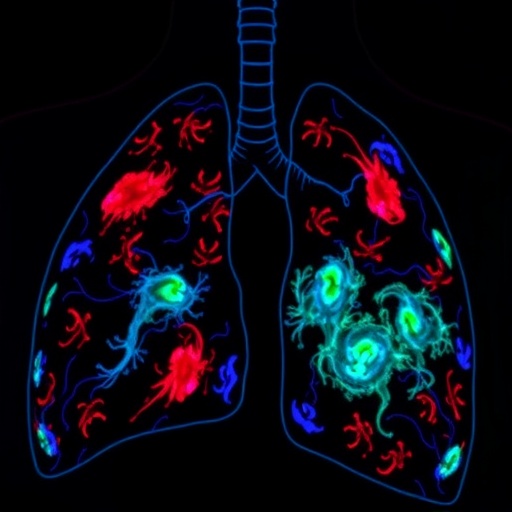In a groundbreaking advancement merging the fields of infrared thermography and single-pixel imaging technology, researchers have developed a novel method for exquisitely mapping the temperature of the human inner canthi. This pioneering approach, reported in a recent study published in Nature Communications, unlocks new potentials for non-invasive, precise monitoring of human physiological states through thermal signals, which carries profound implications for medical diagnostics, security screening, and biometrics. The ingenuity lies in harnessing single-pixel infrared imaging thermometry—an elegant yet remarkably powerful technique eliminating the need for complex sensor arrays traditionally used in thermal imaging.
Thermal imaging has long been utilized across various disciplines to capture temperature variations in objects and living tissues. However, conventional infrared cameras rely on multipixel sensor arrays that, despite offering spatial resolution, come with constraints like high production costs, bulky size, and sensitivity to environmental noise. The breakthrough presented by Jiang, Kilcullen, Lai, and their collaborators revolves around a single-pixel detection system paired with computational imaging algorithms, which collectively extract high-fidelity temperature maps from remarkably minimal infrared data. This strategy brilliantly circumvents the pitfalls of traditional infrared cameras by reducing sensor complexity without compromising image quality.
The human inner canthus—the corner of the eyes near the nose—has been identified as an anatomically stable and thermally informative site, reflecting core body temperature variations more reliably than peripheral skin sites. Mapping temperature variations at this location has significant clinical value, from fever screening in infectious disease monitoring to early detection of circulatory or neurological conditions. The ability to capture precise temperature maps non-invasively and without expensive multi-element sensors lays the groundwork for compact, portable devices potentially revolutionizing routine health assessments and biometrics-enhanced personal security systems.
At the heart of this technological leap is the use of a single-pixel infrared detector, which, unlike traditional focal plane arrays, detects infrared radiation without spatial resolution by itself. To retrieve spatial temperature information from these non-spatial measurements, the research team implemented sophisticated computational imaging techniques including compressed sensing and coded aperture masks. These computational tools effectively multiplex the scene’s spatial information into a series of coded measurements from which a high-resolution thermal image is reconstructed through inverse algorithms and model-based optimization. This approach successfully converts a single sensor element’s limited data into a rich, detailed thermal map.
The implications of using single-pixel imaging extend beyond cost and size benefits. Such systems naturally offer higher sensitivity and signal-to-noise ratios because the entire detector surface area gathers light energy, unlike pixelated arrays where each pixel collects a fraction of total incident radiation. This translates to better thermal contrast and subtler temperature differences being detected, essential when mapping delicate physiological signals at the inner canthi. Furthermore, single-pixel systems exhibit inherent robustness to sensor defects or noise on individual pixels, improving imaging reliability in challenging environments.
In their experiments, the research team demonstrated the thermal mapping capability through human subject testing. They meticulously recorded infrared emission data from volunteers’ inner canthi and reconstructed detailed temperature distributions with micron-level spatial resolution using their single-pixel thermometry setup. The device was able to continuously monitor subtle temperature fluctuations, correlating well with physiological changes such as fever onset or emotional stress responses. These real-time temperature maps highlight the method’s sensitivity, underscoring its promise for wearable health-monitoring technologies where continuous vital sign tracking is paramount.
Beyond healthcare, this imaging modality holds intrigue for security applications such as lie detection and identity verification, where inner canthi temperature patterns serve as unique physiological markers. The integration of single-pixel infrared thermometry into portable scanners could enhance surveillance or authentication procedures without intrusiveness, mitigating privacy concerns associated with video-based facial recognition. Compact, low-cost thermal mapping devices could also augment public health infrastructure by facilitating rapid, on-the-fly fever screening in airports, schools, and other public venues during epidemic outbreaks.
Technically, the system operates within the mid-infrared spectrum, where thermal radiation emitted by human skin peaks. This domain offers an optimal balance between sensitivity to temperature variations and penetration through atmospheric absorption. The researchers employed advanced broadband infrared sources and carefully designed coded apertures crafted to optimize the spatial encoding of the thermal scene. Through iterative reconstruction algorithms that exploit sparsity and statistical priors on natural thermal images, the computational pipeline efficiently processes raw detector signals into meaningful temperature field visualizations.
The challenges overcome to realize this novel thermometry tool are noteworthy. Accurate temperature mapping from single-pixel data requires counteracting noise sources intrinsic to infrared detection, including background thermal fluctuations and detector dark currents. Additionally, precise calibration procedures aligning raw sensor outputs to absolute temperature scales were meticulously developed. The team also addressed computational burdens by optimizing reconstruction algorithms for real-time or near-real-time processing, crucial for practical deployment in clinical or field settings.
This research elegantly exemplifies the synergy between advanced material science, optics, and computational innovation. The single-pixel infrared imaging thermometry approach dismantles longstanding barriers of thermal imaging complexity and cost, propelling the technology into new realms of accessibility and functionality. The potential future applications reach far beyond human health monitoring—from robotic perception to industrial inspection and environmental sensing—where non-contact temperature mapping is vital. This work lays a solid foundation for further explorations of minimalist sensor designs coupled with powerful computational imaging frameworks.
As the researchers look ahead, areas ripe for expansion include integrating the single-pixel thermometry system into wearable platforms or smartphones for ubiquitous health diagnostics. Miniaturization of the optical components and enhancement of sensor sensitivity will further empower continuous, comfortable monitoring across diverse populations. Moreover, coupling this thermal imaging technique with other sensors—including optical, acoustic, or electrophysiological modalities—could yield multifaceted physiological portraits enhancing diagnostic precision and personalized healthcare.
Crucially, this innovation opens exciting interdisciplinary collaboration avenues, enticing physicists, engineers, medical scientists, and data scientists to collectively refine and implement thermal mapping solutions tailored to varied real-world needs. As infectious disease outbreaks and chronic conditions place growing demands on healthcare systems, tools enabling rapid, reliable, and low-cost vital sign assessments will be indispensable. The researchers’ demonstration of high-quality temperature mapping via a single-pixel detector marks a significant stride toward such transformative healthcare ecosystems.
Public enthusiasm around such cutting-edge technology is anticipated to surge thanks to its clear benefits: non-invasive monitoring, streamlined hardware, and broad applicability. The elegant simplicity of single-pixel infrared thermometry resonates beyond academic circles, promising to capture imaginations in media, clinical practice, and technology markets worldwide. By bringing comprehensive thermal imaging within easy reach, this approach empowers individuals and clinicians alike to better understand the nuanced thermal signatures of human health and emotion.
To conclude, the pioneering work by Jiang and colleagues heralds a new era of infrared thermometry where high-resolution temperature maps are accessible with unprecedented simplicity and precision. The single-pixel imaging strategy offers a powerful alternative to conventional thermal cameras, balancing miniaturization, cost efficiency, and imaging excellence. As development proceeds and adoption broadens, we can foresee widespread integration of this technology into daily life, from personalized health monitoring gadgets to enhanced biometric security systems. This advance embodies the thrilling potential of combining minimalist hardware with advanced computational imaging—a paradigm shift redefining how we see and sense the human body’s thermal landscape.
Subject of Research: Single-pixel infrared imaging thermometry applied to mapping temperature variations in the human inner canthi.
Article Title: Single-pixel infrared imaging thermometry maps human inner canthi temperature.
Article References:
Jiang, C., Kilcullen, P., Lai, Y. et al. Single-pixel infrared imaging thermometry maps human inner canthi temperature.
Nat Commun 16, 8885 (2025). https://doi.org/10.1038/s41467-025-64125-3
Image Credits: AI Generated
Tags: biometrics applicationscomputational imaging algorithmshuman physiological states diagnosticsinfrared camera limitationsinfrared thermography advancementsinner eye temperature mappingmedical diagnostics innovationsNature Communications studynon-invasive thermal monitoringsensor complexity reductionsingle-pixel infrared imagingtemperature variations in living tissues




